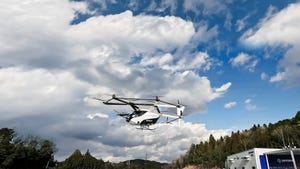Smart Contact Lenses Connect Humans to MachinesSmart Contact Lenses Connect Humans to Machines
The researchers said the lenses could be used to monitor and diagnose medical conditions, improve augmented reality and even connect humans to robots
.png?width=1280&auto=webp&quality=95&format=jpg&disable=upscale)
Researchers have created smart contact lenses that could have potential applications in health care, augmented reality (AR) and even remote robot operation.
The team, from Nanjing University in China, said the new design enables “high-efficient, natural, and effortless human-machine interaction”, using eye-tracking tech to detect a user’s eye motion and identify the desired action.
The chip-free, battery-free lens uses radio frequency (RF) signals to connect the user and machine. Eye movements are picked up by RF tags embedded in the lens, transmitted to the connected system and analyzed to determine the required action in real time.
For AR purposes, the small-scale device can directly project images onto a user’s retina, while it can also be connected to smart devices such as robots to streamline communication.
In a medical context, they could be used to monitor physiological changes, such as fluid pressure in the eye, in real time, and for drug delivery, color deficiency correction and corneal cell repair.
Devices such as Apple’s Vision Pro VR headset already use eye tracking tech to streamline user experience, determining a user’s desired action by tracking their attention.
However, some existing eye-tracking tech is susceptible to environmental light, making it difficult to precisely discern a user’s attention in day-to-day scenarios, according to the researchers.
The use of RF signals, as well as placing the device directly on a user’s eye, mitigates these issues. In tests, the lenses allowed users to play games like Snake and browse the web using only their eye movements for commands.
The team said they plan to improve the design’s flexibility and transparency to expand its potential applications and potentially integrate multiple function modules like field cameras and sensors to achieve intelligent eye-tracking applications.
“These applications could range from consumer behavior research and eye interaction in virtual social settings to diverse medical uses, including visual function assessment, neurological disease diagnosis and treatment, cognitive function assessment, and sleep quality assessment,” the team wrote.
About the Author
You May Also Like








